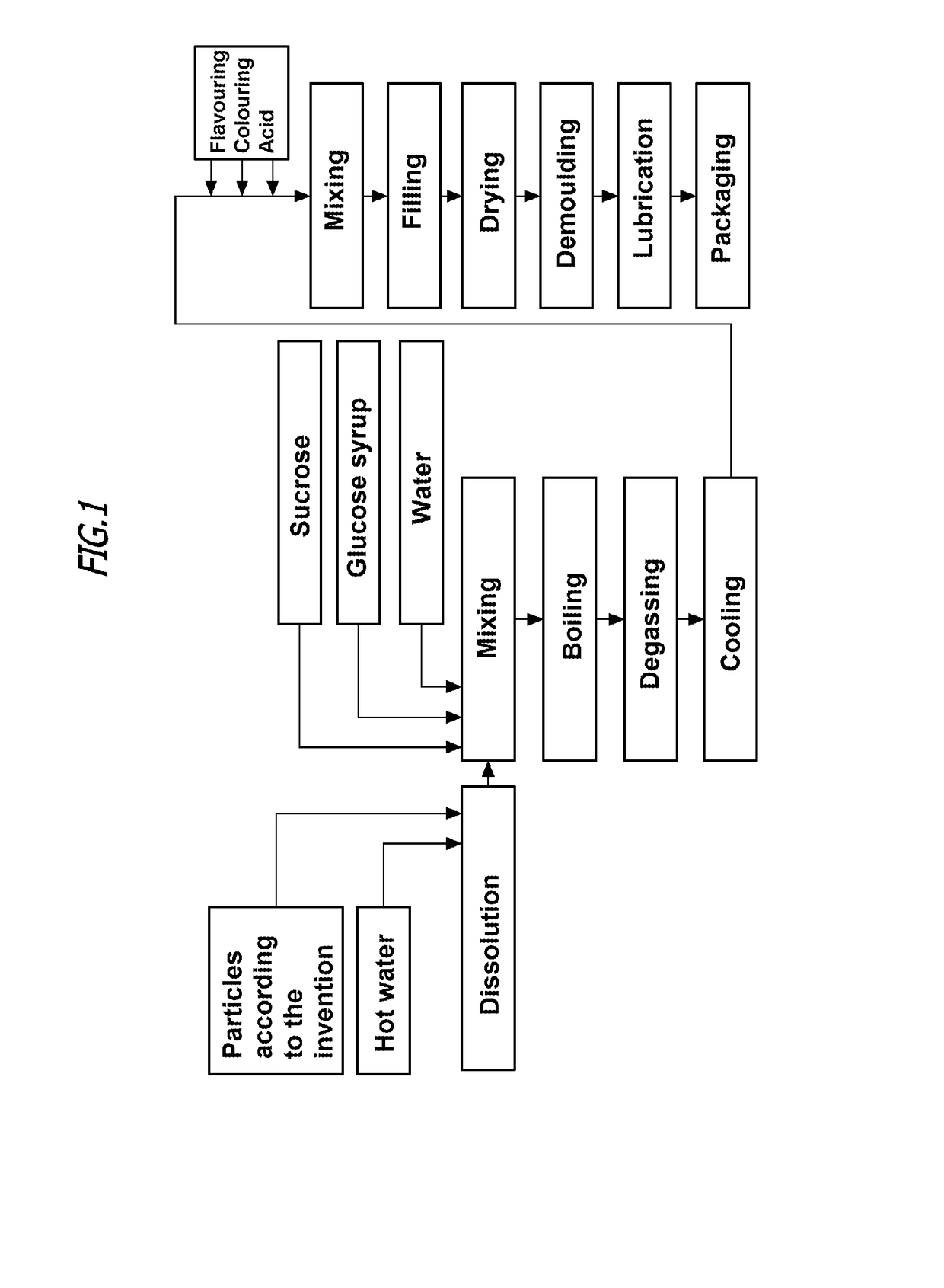Composition in the form of compacted particles and use thereof
a technology of compacted particles and solids, applied in the field of compacted particles, can solve the problems of high risk of lump formation, and only dissolved lumps, and achieve the effect of reducing quick and easy dissolution, and reducing or avoiding the formation of lumps and foam
- Summary
- Abstract
- Description
- Claims
- Application Information
AI Technical Summary
Benefits of technology
Problems solved by technology
Method used
Image
Examples
example 1
[0038]Compacted particles containing gelatin and collagen hydrolysate for the production of “Beauty” gummy sweets.
[0039]A mixture was produced from 28.6 wt % of powdered gelatin (particle size <0.2 mm; bulk weight 582 g / 1) and 71.4 wt % of a collagen hydrolysate (particle size <0.150 mm; bulk weight 304 g / 1), which is obtainable from GELITA AG under the name Verisol®. In order to prevent sticking during the compaction, 0.01 wt % of magnesium stearate was additionally added. This mixture was subjected to a compaction process, wherein the proportion having a particle size between 1 and 4 mm was defined as desired end product (desired granular product).
[0040]The mixture was compacted at a rate of 80 kg / h and under a pressure of 40 kN, and was ground and sieved. The yield for one compaction cycle was 72%. There were no oversized grains, since the fine grain proportion of 28% was directly fed back continuously to the compaction process.
[0041]The desired granular product proportion had a ...
example 2
[0045]Compacted particles containing gelatin and collagen hydrolysate for the production of reduced-sugar gummy sweets.
[0046]A mixture was produced from 24 wt % of powdered gelatin (particle size <0.2 mm; bulk weight 612 g / l) and 76 wt % of a collagen hydrolysate (particle size <0.15 mm; bulk weight 320 g / l), which is obtainable from GELITA AG under the name Peptiplus®. In order to prevent sticking during the compaction, 0.01 wt % of magnesium stearate was additionally added. This mixture was subjected to a compaction process, wherein the proportion having a particle size between 1 and 4 mm was selected as the desired granular product.
[0047]The mixture was compacted at a rate of 73 kg / h and under a pressure of 45 kN, and was ground and sieved. The yield for one compaction cycle was 75%. There were no oversized grains, the fine grain proportion of 25% was directly fed back continuously to the compaction process.
[0048]The desired granular product proportion had a mean grain size of 3 ...
example 3
[0052]“Complete compound” based on instant gelatin for the production of jelly
[0053]A mixture was produced from 10 wt % of instant gelatin (particle size <0.17 mm; bulk weight 347 g / l), 88.3 wt % of castor sugar (fine-grain sucrose), 1.7 wt % of citric acid powder, and appropriate amounts of flavourings and colourings. This mixture was subjected to a compaction process, wherein the proportion having a grain size between 0.1 and 0.5 mm was selected as the desired granular product.
[0054]The mixture was compacted at a rate of 81 kg / h and under a pressure of 80 kN, and was ground and sieved. The resultant desired granular product proportion had a bulk weight of 684 g / l.
[0055]By stirring 120 g of these particles according to the invention into 500 ml of cold water, the ready-to-eat jelly product was obtained after a defined cooling time.
PUM
| Property | Measurement | Unit |
|---|---|---|
| wt % | aaaaa | aaaaa |
| wt % | aaaaa | aaaaa |
| mean particle diameter | aaaaa | aaaaa |
Abstract
Description
Claims
Application Information
 Login to View More
Login to View More - R&D
- Intellectual Property
- Life Sciences
- Materials
- Tech Scout
- Unparalleled Data Quality
- Higher Quality Content
- 60% Fewer Hallucinations
Browse by: Latest US Patents, China's latest patents, Technical Efficacy Thesaurus, Application Domain, Technology Topic, Popular Technical Reports.
© 2025 PatSnap. All rights reserved.Legal|Privacy policy|Modern Slavery Act Transparency Statement|Sitemap|About US| Contact US: help@patsnap.com

